From the NILU annual report 2017: Oil spills, tanker accidents, chemical disasters – suddenly materials are released into the environment, potentially harming both humans and nature. Is it possible for scientists to trace the environmental offenders?
– The answer is yes, says Stephen Michael Mudge, senior scientist at the Environmental Impacts and Sustainability Department at NILU. .
Environmental CSI
This field of science is called environmental forensics, and it sounds a lot like hands-on work at a crime scene.
– It is actually not that different as every contact leaves a trace, Mudge explains.
– Environmental forensics describes the scientific study of contaminants in the environment. With the aid of modern technology, we can identify their source(s), the hazard posed, the time between release and measurement and the magnitude of any biological effects.
Knowing all this also helps when deciding on the best remediation strategy. Such approaches may be used by industries, regulators and lawyers, both during and after contamination events.
Source – pathway – receptor
Mudge has a long expertise from many environmental forensic cases.
– Usually, we are looking for one or more potential sources of contaminants to the environment, he explains. – The contaminants often use multiple pathways by which they may be transported from the source to a receptor. This may be in the air, water, sediments or soil, or plants, animals and humans. If the receptor is a living organism, it is also necessary to measure the potential effects the source(s) may have on the living organism.
The “Polluter Pays” Principle

The “polluter pays” principle has been an important aspect of recent environmental legislation, although the simplicity of the phrase hides a complex series of questions: Who is/are the polluters? How much did each contribute to the system? What “damage” did they cause? Can you differentiate between historical and natural sources and recently spilled compounds? What should the polluters pay for? How do you “compensate” for the damage? Environmental forensic investigations can answer these questions.
Environmental forensics at NILU
Environmental forensics is a new field at NILU. NILU already has significant analytical capabilities, and the development of the environmental forensic approach will make use of these sensitive instruments to provide additional insight into the state of the environment.
This will also be extended into the reconstruction of environmental histories to provide evidence of change in the environment. These changes may be due to natural processes, climate induced alterations or through technological events. This includes spills, planned or unplanned. For instance, certain trees are good at recording some of the airborne contaminant load within their rings. Analysis of these rings can provide a relatively high-resolution record of the concentration of these contaminants reached in the past.
– Environmental forensics is a very exciting field that offers for a range of research opportunities. I’m quite excited to implement this field further at NILU, says Mudge.
